Nick and Tesla's High-Voltage Danger Lab
by Steve Hockensmith and "Science Bob" Pflugfelder, illus. by Scott Garrett
Nick and Tesla Holt, 11-year-old twins, star in a middle-grade novel sure to appeal to mystery and adventure fans, as well as to budding scientists who enjoy devising experiments such as erupting volcanoes.
Steve Hockensmith (Pride and Prejudice and Zombies) sets this madcap mystery in San Francisco's Half Moon Bay, where the twins are staying for the summer with their uncle (either a genius or a madman, they're not sure at first). Their discoveries and adventures in a new town drive this fun- and scientific fact–filled novel as they invent contraptions that help them escape from tight spots--and just as often draw them into difficult dilemmas. "Science Bob" Pflugfelder, an elementary schoolteacher and TV personality, provides instructions for replicating the clever devices made by the twins, so readers may join in the excitement.
The siblings' first task is to get from the San Francisco International Airport to their uncle's home at 513 Chesterfield Avenue when he does not show up to meet their plane. That's readers' opening hint at Uncle Newt's character. A reluctant taxi driver takes them to their destination and notices a black SUV trailing them for the entire trip. After a runaway self-propelled mower drifts from Uncle Newt's lawn to a neighbor's garden, the siblings enter Newt's unlocked house and eventually find him literally glued to the basement floor with orange goo. (He'd been dabbling with a formula for "instant spray-on clothes" with a bit too much of an adhesive property.) Luckily, the purple spray antidote to the orange goo is within reach of his niece and nephew, who use it to free him.
Thus, readers quickly learn of Uncle Newt's scientific inclinations and the array of lab accoutrements and chemicals at the children's disposal. As the book continues, the twins often find themselves operating independently (their uncle, who works for a top-secret government agency, is absent a lot--either physically or due to scientific preoccupations). They make a bottle rocket and launcher to entertain themselves; glares from the neighbor with the demolished garden prompt them to head to a vacant lot to test it. But the twins break Science Bob's first rule: "Never stand over an unlaunched rocket." Tesla does, with the pendant her parents gave her dangling over the neck of the bottle rocket. The rocket flies and takes her pendant with it. It lands behind the fence surrounding the town's landmark "old Landrigan place"--guarded by Rottweilers and a pair of suspicious "construction" guys.
That leads to their next invention: a "Mints and Soda-Fueled RoboCat Dog Distractor." They figure if Tesla can distract Jaws and Claws (the Rottweilers) with it, Nick can hop over the fence and retrieve the pendant from where they saw it land. Only the necklace isn't there. And Nick spies a girl in an upstairs window of the old Landrigan place.
How Nick and Tesla search for the pendant and the identity of the mysterious girl makes for a suspenseful read. They make friends in the neighborhood, DeMarco and Silas, and enlist their help in their detective work. The black SUV reappears--is the driver friend or foe? Nick and Tesla devise a clever way to follow the "construction" guys' van as they depart the Landrigan place; it's an experiment with readily available components, and kids will thoroughly enjoy using a black light to "follow the trail" (as Science Bob puts it in his final instruction) of whomever they're tracking. The kids also rig up an alarm system in case whoever is in the black SUV tries to break into Uncle Newt's house--a handy way to reinforce the "keep out" sign on any bedroom door.
The brief, liberally illustrated chapters, combined with five experiments (timed to fall right when Nick and Tesla are creating them in the lab, and replete with humorous asides from Science Bob), make this an involving reading experience for a diverse audience. All of Science Bob's experiments have been tested for their reliability and ease of locating the essential components. Whether readers want a suspenseful adventure, fun projects they can do at home, or a combination of both, they'll find much to entertain (and educate) them in these pages and will look forward to the next episode, Nick and Tesla's Robot Army Rampage. --Jennifer M. Brown
Instructions for bonus gadgets will appear on www.NickandTesla.com (which launches on October 1), along with videos of science experiments, sneak previews of future Nick and Tesla mysteries and more.



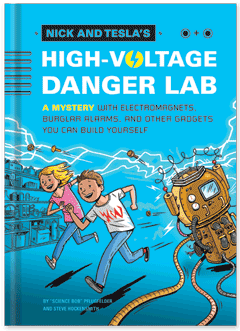

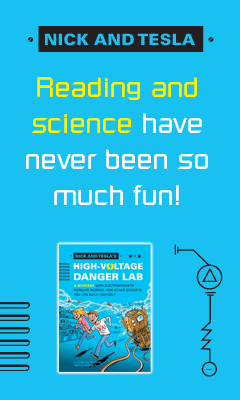
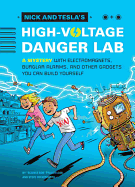

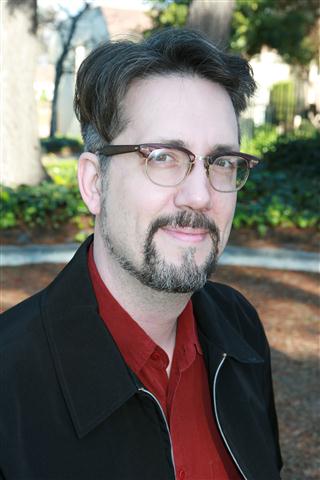

 BP: I think it will be interesting to see what percentage of the kids actually build the projects because that attracts them, and what percentage enjoys the storyline. People will say, "What's the book about?" I'll tell them, and add that we'll have the instructions for the projects in the book. When I tell librarians that, they light up and say, "I have a kid that will really like that."
BP: I think it will be interesting to see what percentage of the kids actually build the projects because that attracts them, and what percentage enjoys the storyline. People will say, "What's the book about?" I'll tell them, and add that we'll have the instructions for the projects in the book. When I tell librarians that, they light up and say, "I have a kid that will really like that."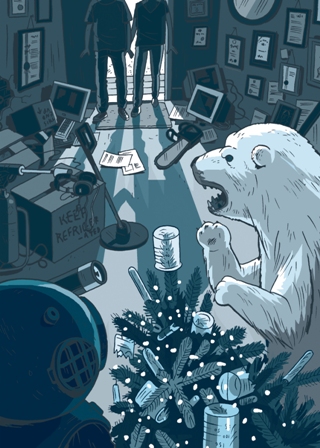 Tell us more about Uncle Newt--what an interesting character.
Tell us more about Uncle Newt--what an interesting character.